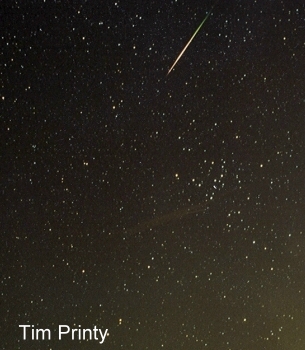
Observing the Leonid sub storms
© Tim Printy
My experience with the Leonid meteor show has had it's ups and downs. Back in 1996, I observed a wonderful fireball display from Chiefland, Florida with rates below 60 an hour. This was an incredible event but this was more of a cat's purr than a Lion roar. Between 1997-2000, I was stationed in Hawaii aboard a submarine. This made observations of the Leonids difficult. The 1999 event was observed but only through holes in the clouds. I did see bright fireballs but nothing too extraordinary. By November 2000, I had retired from the Navy and resided in Manchester, New Hampshire. Unfortunately, we were treated with typical cloudy weather for the November 2000 storm. I had to read about the event from friends in Florida, who witnessed a magnificent display. Despite this disappointment, I had high hopes for the 2001 meteor storm.

Bright Leonid from 1996
Fortunately, the weather held in 2001 and the evening of the 17th boasted only a small amount of haze that cleared shortly after midnight. Of course, there was a trade off. Clear skies also meant subfreezing temperatures to put a little chill in our bones. My wife, Pollyann, and I left the house around 11PM and arrived at the New Hampshire Astronomical Society's dark sky site shortly after midnight dressed for the cold weather. After settling in, we were immediately treated with a display that was already at rates better than my 1996 observations. Recording the essential data of each meteor, I was able to count 47 Leonids in the time period between 1:40-2:40 AM EST (0640-0740 UT). Several were bright fireballs and many left trains. In order to be ready for the peak display time, we then took a break in order to warm up and get something to drink. We could hear each "OOOO" and "AAHHH" from inside and it was clear to me that rates were already picking up. By the time I resumed my counts at 3:25AM (0825 UT), rates had doubled to 100 an hour. The fireballs continued to fly and several long trains were observed. One lasted six minutes. I recorded 15 meteors of magnitude -4 or greater during my data recording. Three were as bright as -8 and cast shadows. As Leo continued to rise, I began to realize that I had difficulty recording the data for each meteor. By 4:25 (0925 UT), Leonids were being seen at about 3 per minute. This was not unexpected and I had come somewhat prepared. I should have bought a tape recorder but I opted for a simpler approach. I performed 10-minute counts with a simple hand counter, which I advanced every time I saw a Leonid. This worked well and I was able to easily record the number of meteors without any need for looking down at my clipboard. By 5AM (1000 UT), the time of the predicted peak, the rates had more than tripled to 10 per minute (600 meteors per hour)! There were point meteors and instances of multiple meteors appearing at the same time.
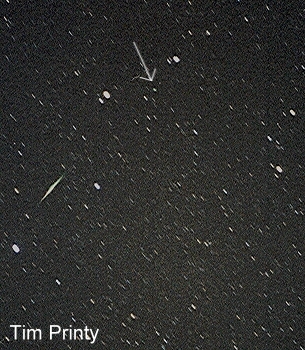
Two Leonids are visible. The first is obvious. The second is a point meteor from the radiant (see arrow).
The one distinct characteristic I noted was the Leonids were quick and over half left trains. Additionally, the average magnitude hovered around +0.5 from the data I recorded prior to 0925UT. This value may have been skewed by the large number of fireballs that were recorded. A basic graph of 10 minute periods shows how the rates rose. I performed a rough computation of the ZHR as well
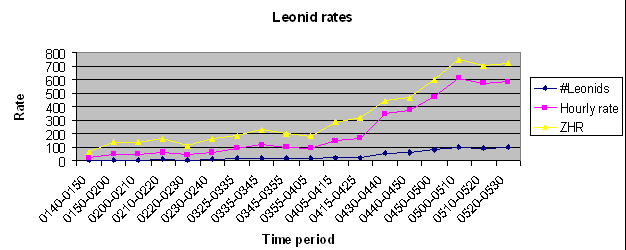
By 5:30 AM (1030 UT), twilight began to interfere and I chose to end my counts. Yet, as I was accumulating my gear, I could see more meteors crossing the sky and got the feeling that the rates were still climbing. It is very possible we missed the predicted meteor storm by only 30-60 minutes. As Polly and I drove away that morning, I had to wonder if we had seen the storm that was predicted. At first glance, one might say yes but after looking back at the records for the 1966 storm, I would say we got second best. According to those accounts, an observer had the impression of earth's motion through space (sort of like the windows screen saver at warp speed). While there were brief flurries of this type of activity, we never were able to get the full effect. Still, I would not have missed it for the world. It was an impressive display that has to go in any observer's record book as a night to remember. The lion roared for us but not as loud as it could have.
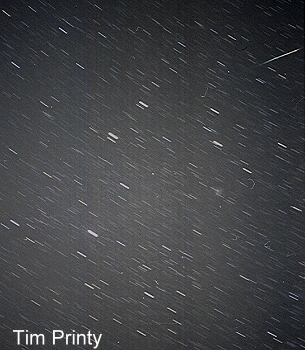
A bright Leonid coming from the radiant
The 2002 display had potential as well for a meteor storm. However, the moon was to interfere with a waning gibbous washing out many meteors. As a result, I decided to stay at home to do my counts. My home in suburban Manchester is pretty good for observing meteors and I can see all the stars in the little dipper on a clear night. On this cold morning in November, I performed counts between 5:05 and 5:38 AM EST (1005-1038 UT) using a tape recorder. Unlike the previous year, rates were comparatively low at the start of my observations. Between 1005-1025 UT, I counted 29 Leonids, which computes to a rate of 87 Leonids an hour. This is high but not as high as the year before. Around 1026 UT, rates suddenly began to increase with many meteors being seen each minute. Between 1025-1038 UT, I counted 39 meteors, which computes to a rate of about 180 per hour. Several one minute periods boasted five leonids. This computes to a rate of 300 per hour. A very respectable rate but not the same as 2001. A graph of five minute intervals shows a good spike just before dawn.
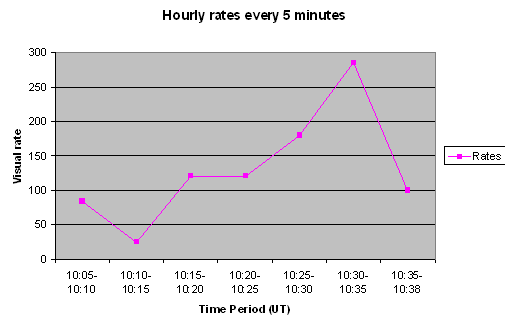
Compared to the 2001 Leonids, the 2002 event was populated by many more faint meteors. Average magnitude was just above +2 and only one meteor brighter than -1 was observered (it was only -3). The 2002 display was not a match for the 2001 event but it was a respectable considering the fact that the moon interfered. The Lion's roar shifted towards a growl.
I did not observe the shower in 2003 or 2004. Rates were pretty low from what I can tell. The lion appears to have gone back to sleep. Based on what I have read, the next time the Leonids might give a good display will not be for another few decades. Even then, the predicted rates appear to fall short of the rates seen in 2001. If one is looking for a meteor storm, one might want to keep an eye out for other sources. This website has some information concerning possible storms in the future. One can only hope that I get another chance in my lifetime to see such an event.
In retrospect, I wish I had done some things differently. The 2001 display was the best I observed and I should have recorded my observations on audio tape allowing for better observations of the shower. My photographic efforts were less than satisfactory. I had several camera failures in the cold weather and as a result only one was operational for the 2001 event. Despite multiple fireballs, I did not capture any on film. I did manage to capture many fainter meteors but nothing that was too impressive. There were many lessons learned and hopefully I will be able to employ them at a future date.